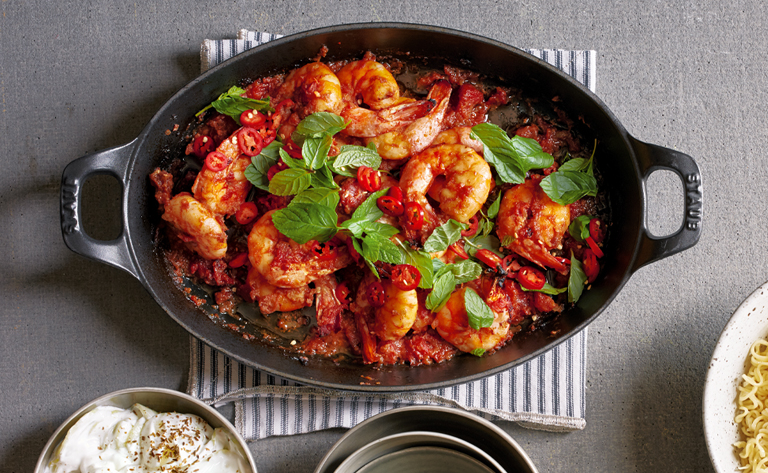
by Tomato Wellness | Jul 29, 2021 | Food and Nutrition
An increasing body of evidence links consumption of tomato products with reduced risk of prostate cancer. Here’s a look at what the latest science says.
The idea that something as simple as eating tomato products could potentially fend off prostate cancer is exciting. After all, the American Cancer Society estimates nearly 250,000 new cases of prostate cancer in the U.S. each year, resulting in more than 34,000 deaths. In fact, one man in eight will be diagnosed with prostate cancer during his lifetime. A body of evidence supporting the benefits of tomatoes for reducing the risk of prostate cancer has mounted over the past several years. And the latest research includes a number of studies that continue to demonstrate the promise of tomato consumption on prostate cancer protection.
What’s so special about tomatoes? They contain a variety of nutrients that may be responsible for cancer-fighting action, including vitamins A and C, fiber, and potassium, as well as a group of powerful plant compounds known as carotenoids, which give tomatoes their red, yellow, and orange colors. The most abundant carotenoid found in tomatoes is lycopene, followed by phytoene, phytofluene, zeta-carotene, gamma-carotene, beta-carotene, neurosporene, and lutein.
Numerous studies have linked lycopene consumption with cancer protection—in particular for prostate cancer. While lycopene is present in other fruits such as watermelon and pink grapefruit, tomatoes, which are the second most consumed vegetable (second to potatoes) in the U.S., account for more than 85% of the lycopene in the American diet. Interestingly, cooked tomato products—as in processed tomatoes, including tomato sauce and canned tomatoes—may hold particular significance. The lycopene from cooked and processed tomatoes is more bioavailable than that of fresh tomatoes. Heating or processing breaks down the tomato cell matrix and promotes isomerization of lycopene from all-trans isomers to the more bioavailable form of cis-isomers. Research shows that single daily servings of processed tomato products produce significant increases of lycopene concentrations in blood and buccal mucosal cells in healthy adults.
Tomatoes’ cancer protection isn’t merely due to lycopene. Compared to lycopene alone, more effective benefits have been linked with consumption of the whole tomato, which contains a full range of carotenoids and nutrients. Lycopene has strong antioxidant capacity that may provide cancer protection, but there may be other factors at play, such as altering gene expression, anti-inflammatory effects, and alterations in cancer cell cycle.
To add to the growing body of research on the mechanisms of action related to tomato products and cancer, a 2020 review of studies was published in Biomedicine & Pharmacotherapy. Researchers found that lycopene—the compound found in tomato products—has anti-cancer, anti-progressive, and apoptotic effects on prostate cancer. The clinical studies reviewed showed evidence supporting the continuous inclusion of dietary lycopene for different types of cancers, especially prostate cancer. Lycopene was found to effectively suppress progression and proliferation, arrest in-cell cycle, and induce apoptosis of prostate cancer. In addition, lycopene was shown to signal the pathways for the treatment and prevention of prostate cancer. A double-blind placebo-controlled study in the review showed that after 28 days of consuming lycopene-rich juices, patients’ serum lycopene levels were 80% higher compared to patients given a placebo, which could help reduce risk of disease. Another study in the review showed men with newly diagnosed prostate cancer who received lycopene twice a day for three weeks had decreased the risk and growth of prostate cancer cells.
In a prominent 2020 study from Loma Linda University, researchers examined how tomato consumption might impact the development of prostate cancer by looking for significant relationships between diet and prostate cancer in nearly 28,000 men as part of the landmark cohort Adventist Health Study-2 Among participants, who were cancer-free men at the outset and were followed for nearly eight years, those who consumed canned and cooked tomatoes more than four times a week were at lower risk of developing prostate cancer compared to those who did not eat cooked tomatoes and tomato products. Men who consumed them five to six times per week decreased their risk by 28% compared to those with no intake. The results from the Adventist Health Study-2 conclude that consumption of canned and cooked tomatoes may reduce risk of prostate cancer.
Including lycopene-rich foods, like tomato products, as a supplementary therapy for prostate cancer is the basis of some of the latest scientific research, which has shown the potential for limiting prostate cancer cell growth as well as inducing cell death. A 2020 study examined the role of lycopene on growth factors, which play important roles in cancer development and metastasis. Binding to insulin-like growth factor, lycopene has a protective effect, which affects the pathways of this growth factor, and stimulates cancer cell death. In the study, researchers removed cancer cells from patients with varying progression of prostate cancer and measured lycopene concentrations and levels of insulin-like growth factor. There was significant difference in the mean growth factor levels at various concentrations of lycopene, increasing it as lycopene increased. Researchers concluded that lycopene could be beneficial to prostate cancer patients as a supplementary therapy to increase cancer cell death and inhibit the progression of cancer cells.
There’s still more to learn about how tomatoes protect against prostate, but the evidence to date supports incorporating foods that contain lycopene. Consuming a few more tomatoes and tomato products in the diet each week is an easy and nutritious way to do so.
Written by Sharon Palmer, MSFS, RDN
References
- Fraser GE, Jacobsen BK, Knutsen SF, Mashchak A, Lloren JI. Tomato consumption and intake of lycopene as predictors of the incidence of prostate cancer: the Adventist Health Study-2. Cancer Causes Control. 2020;31(4):341-351. doi:10.1007/s10552-020-01279-z
- Key Statistics for Prostate Cancer. American Cancer Society. https://www.cancer.org/cancer/prostate-cancer/about/key-statistics.html. Accessed July 28, 2021.
- Mahdi, Mirahmadi, Shayan, Azimi-Hashemi, Ehsan, Saburi, Hossein, Kamali, Mandana, Pishbin, Farzin, Hadizadeh. Potential Inhibitory Effect of Lycopene on Prostate Cancer. Biomedicine & Pharmacotherapy. 2020;129. https://doi.org/10.1016/j.biopha.2020.110459
- Park, H., Kim, YJ. & Shin, Y. Estimation of daily intake of lycopene, antioxidant contents and activities from tomatoes, watermelons, and their processed products in Korea. Appl Biol Chem 63, 50 (2020). https://doi.org/10.1186/s13765-020-00534-w
- Potatoes and Tomatoes are the Most Commonly Consumed Vegetables. USDA Economic Research Service. https://www.ers.usda.gov/data-products/chart-gallery/gallery/chart-detail/?chartId=58340. Updated December 16, 2020. Accessed July 28, 2021.
- Tjahjodjati, Sugandi S, Umbas R, Satari M. The Protective Effect of Lycopene on Prostate Growth Inhibitory Efficacy by Decreasing Insulin Growth Factor-1 in Indonesian Human Prostate Cancer Cells. Res Rep Urol. 2020;12:137-143. Published 2020 Apr 17. doi:10.2147/RRU.S232745

by Tomato Wellness | Jul 22, 2021 | Media Recipe, Recipes
Looking for a healthy, protein-packed recipe for this summer? This Picadillo-Style Beef Stir-Fry is one dish that you don’t want to miss out on! This recipe calls for sirloin steak, potatoes, green bell peppers, tomato sauce, and seasonings galore. It can be served with a warm flour tortilla, hot cooked rice, or refreshing salad with greens. For additional flavor and crunch, you can also throw on some toasted sliced almonds, chopped fresh cilantro, and sour cream. This dish only requires 45 minutes of cooking time, and can be stored for up to two days, which means you can save time and meal prep with the remaining leftovers. Enjoy hot out of the oven or chilled down from the fridge to switch things up during the week.
Thanks to the addition of tomato products, you can avoid dried-out meat and boost the juiciness of many recipes. The addition of canned tomato sauce found in this Picadillo-Style Beef Stir-Fry adds a savory, mouth-watering flavor that is guaranteed to make your taste buds sing. These tomato products are also great for your short and long-term health! Canned tomatoes are a good source of lycopene, an antioxidant that gives tomatoes their vibrant, beautiful red color. Antioxidant-packed foods are beneficial for reducing risk of heart disease and cancer. In fact, studies have shown that canned tomatoes contain more lycopene than raw/fresh tomatoes. So, what are you waiting for? Go ahead and add canned tomatoes to your favorite dishes this summer!
Get the full recipe for Picadillo-Style Beef Stir-Fry by visiting our friends at the National Beef Council.
If you’re looking for other delicious recipes, check out some of our favorites:
Breakfast Egg Bake
Muhammara Walnut Shakshuka
California Avocado Veggie-Packed Meatloaf

by Tomato Wellness | Jul 15, 2021 | Media Recipe, Recipes
This nutritious California Walnut Salsa recipe is not only packed with flavor, but it can be prepared in under 10 minutes. This specific salsa recipe also contains roasted red peppers, jalapeno peppers, and toasted walnuts—giving it an extra kick of flavor and crunch. All you need to do is stir all the ingredients into a medium-sized bowl, cover, and refrigerate it until it’s ready to serve. It doesn’t get much easier than that! Serve it up with your favorite veggies and a side of whole-wheat tortilla chips for a tasty snack that is sure to be a crowd-pleaser.
What’s the key ingredient to any salsa? That’s right, tomatoes! Every salsa requires tomatoes, and canned diced tomatoes do just the trick to create a simple, flavorful salsa. Not only do canned tomatoes provide a boost of juiciness to a dish, but they also have numerous health benefits. This specific recipe calls for canned fire-roasted diced tomatoes, but you can also use regular canned diced tomatoes for a different flavor profile. The mixture of onions, fresh cilantro, lime juice, garlic, and spices provides the perfect combination of savory and spicy flavor. Don’t be shy and feel free to add more spices and veggies for even more spice!
While fresh, chopped tomatoes can be used for salsa, it’s actually better to use the canned version! Research has shown that canned tomatoes are actually higher in nutritional value than fresh tomatoes due to the canning process (and they’re more affordable). When canned tomatoes are placed into their homes (aka the cans), they are stored at nutritional peak, providing them with maximum nutrition. What’s not to love about that? So, incorporate some nutrients into your daily diet than by enjoying a refreshing bowl of salsa.
Get the full recipe for California Walnut Salsa by visiting our friends at California Walnuts.
For other delicious dip recipes, check out:
The BEST BLT Dip
Tomato Pesto Hummus

by Tomato Wellness | Jul 13, 2021 | News
What is one of the many powers that tomatoes have on human health? They help to reduce the risk of certain types of cancer! Learn more about the antioxidant properties of lycopene and canned tomatoes when it comes to cancer prevention.
It’s important to make sure that we are fueling our bodies with the proper nutrients to live a healthy lifestyle. This includes eating well-balanced meals that contain foods such as fruits, vegetables, whole grains, and lean protein. One source of food that is guaranteed to boost nutrient intake is tomatoes and tomato-based products. Tomatoes contain lycopene—a carotenoid that gives tomatoes their vibrant red color and has various health benefits–which plays an integral role in the improvement of heart health, protection from the sun, and reduction in certain types of cancer.
The incorporation of lycopene-rich foods, especially tomato-based products, have been shown to boost overall health. One specific research study gathered 19 healthy human subjects to identify the impacts that the consumption of tomato-based products—tomato juice, spaghetti sauce, and tomato oleoresin—had on each individuals’ body when the certain tomato-based products were consumed for a period of one week. The results of the study showed that since these products contain dietary lycopene, which is found in tomato products, they may act as antioxidants. In addition to the antioxidant properties found in tomatoes, lycopene is readily absorbed from tomato products. When food is readily absorbed by your body, it aids in gut health and digestion. Therefore, the correlation between lycopene, antioxidant powers, and tomatoes is strong, and researchers suggest that tomatoes can play a crucial role in the prevention of cancer.
As previously mentioned, tomato juice, spaghetti sauce, and other sources of tomato products can improve health and reduce risk of diseases. This goes to show that eating healthy can be made simple. For example, if someone told you to eat pasta with tomato-based spaghetti sauce to boost your nutrient intake, you would easily agree because it’s THAT easy! The best part about tomatoes is that they are extremely versatile and can be paired with both sweet and savory ingredients to whip up a flavorful, nutrition meal. So let’s get cookin’ with canned tomatoes!
Check out some delicious recipes featuring canned tomatoes:
Pan Seared Pork Chops with Bourbon Peach Compote
Easy Chicken Curry
Pizza Stuffed Chicken
The BEST BLT Dip

by Tomato Wellness | Jul 10, 2021 | Media Recipe, Recipes
Looking for a new dinner recipe to spice things up? This Prawn and Tamarind Curry dish is a simple, delicious meal that can take your recipe-making skills to the next level. There are two main parts to this dish: the curry and the cucumber raita. The cucumber raita is an Indian side dish that contains cucumbers, greek yogurt, and spices. The curry component of this dish includes a mixture of tomato sauce, ginger, garlic, and mint that puts a unique spin on the usual seafood dish. The combination of these two parts perfectly balances out the sweet and spicy levels found in this dish. If you want more spice, feel free to add more red chili seeds! This flavor-packed dish can be served with noodles, rice, tortilla, or salad. Thanks to its versatility, it enables you to either eat it hot or cold, depending on what you’re craving that day.
One important ingredient found in the curry portion of this recipe is canned chopped tomatoes. You can’t forget this important ingredient because it adds a boost of flavor and juiciness to the dish, and who wouldn’t want that? The integration of canned tomatoes doesn’t only make the dish taste more flavorful, but it enhances the amount of nutrients already present. Canned tomatoes are a good source of vitamin C, vitamin A, folate, and potassium, which have been shown to lower certain types of cancers and diseases.
When searching for canned tomato products at the grocery store, keep these two tips in mind to ensure you are receiving the best quality possible:
- To find the perfect can, you should watch out for any cracks, dents, leaks, or any other deformities found on the exterior of the can.
- If the cans appear to be damaged or dusty, try your best to avoid these ones and aim to purchase the cans that look like they are in tip-top shape.
With these tips in mind, go ahead and whip up this delicious curry for dinner tonight! Thanks to flavors like this, you won’t be disappointed.
Get the full recipe for Prawn and Tamarind Curry with Chunky Cucumber Raita by visiting our friends at the National Dairy Council.
For other delicious recipes, check out some of our favorites:
Pan Seared Pork Chops with Bourbon Peach Compote
Easy Chicken Curry
Pizza Stuffed Chicken
Green Chile Posole Soup
California Avocado Veggie-Packed Meatloaf





Recent Comments